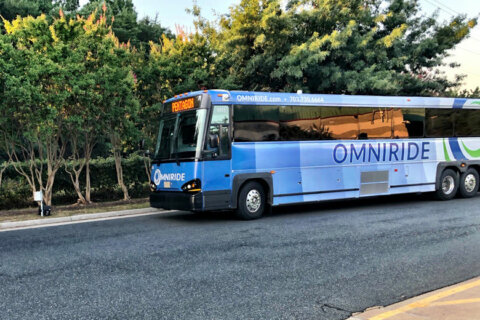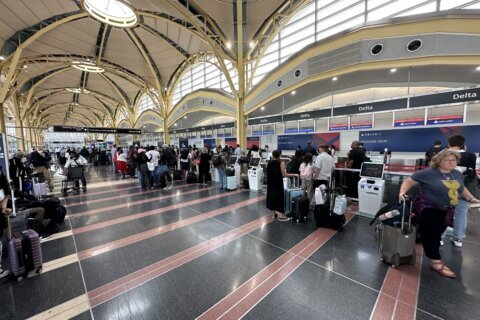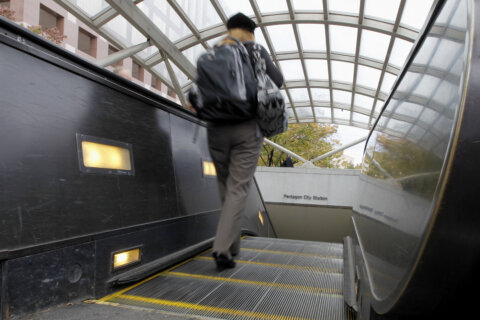This article was republished with permission from WTOP’s news partners at Maryland Matters. Sign up for Maryland Matters’ free email subscription today.
This content was republished with permission from WTOP’s news partners at Maryland Matters. Sign up for Maryland Matters’ free email subscription today.
Transportation advocates and business interests in the national capital region have long dreamed of extending Northern Virginia’s Beltway toll lanes across the Potomac River and into Montgomery County — preferably using the commonwealth’s established vendor, Transurban.
That dream is a huge step closer to reality following the Maryland Department of Transportation’s selection last week of Accelerate Maryland Partners, a consortium led by Transurban, to do “predevelopment” work on its Capital Beltway (Interstate 495)/I-270 road widening project.
It also brought expressions of cynicism from opponents of MDOT’s plans.
Virginia officials embraced the concept of variably-priced “express lanes,” in which motorists willing to pay for the privilege can buy their way out of congestion, more than a decade ago.
Transurban, an Australian behemoth whose North American headquarters is in Tysons Corner, Va., has built a 63-mile network of such roads, primarily in Fairfax, Virginia’s largest and most prosperous county.
But Maryland has largely resisted the lure of express lanes. According to some observers, it’s one of the reasons why Northern Virginia, which recently lured the coveted Amazon “second headquarters” development, appears more robust.
Without buy-in from Maryland powerbrokers, political and business leaders long argued, the capital region’s ability to ease congestion on some of the nation’s worst roads was going to be limited, particularly given Montgomery County’s long-held opposition to a new bridge upriver from the American Legion Bridge.
“Based on a lot of transportation issues — where people start and end their trips — as well as Maryland’s position on a western crossing, at this point staff is recommending to the Commonwealth Transportation Board that they focus on extending [high-occupancy toll] lanes across the American Legion and onto the Maryland side of the Beltway,” Virginia’s then-Deputy Transportation Secretary, Nick Donohue, told WAMU Radio in 2015.
Two years later, in 2017, Maryland Gov. Lawrence J. Hogan Jr. (R), riding high in the polls, and then-Transportation secretary Pete K. Rahn sprung their plan to add four lanes to the two highways on unsuspecting local leaders.
At the time there was little, if any, talk about allowing commuter buses to use the new lanes free of charge or expanding transit — only the benefits of wider highways, which Hogan (R) said would be a “game-changer” for Maryland’s weary commuters.
Canaan Merchant, a transportation and land-use reporter for Greater Greater Washington, seemed to glimpse the future in 2015, at the exact time Donohue was starting to ramp up pressure on Maryland to follow his state’s lead.
High-occupancy toll, or HOT, lanes — which allow carpools, van-pools and buses to use privately-financed express lanes for free — represented “a compromise,” he said.
“It’s not the pure transit-only plan that smart growth advocates have pushed, but it’s also not the outer beltway that highway advocates wanted,” Merchant wrote.
“HOT lanes give highway advocates a big road project, and throw transit advocates a bone with the potential for express buses (Montgomery County’s [bus rapid transit] plan talks about transit over the Legion Bridge). Nobody gets exactly what they want, but nobody’s worst nightmares happen either,” he added.
“Virginia’s proposal to bring HOT lanes to I-66 is moving very rapidly,” Merchant concluded. “If Maryland decides to play along, this could move rapidly too.”
Transportation advocates quibble with the “very rapidly” notion. But they are delirious with Hogan’s selection of the Transurban-Macquarie group, which they say gives commuters the opportunity to cruise across state lines using a single payment system.
“Now the Express Lanes in the National Capital Area will become seamless,” crowed John B. Townsend II, director of government and public affairs for AAA Mid-Atlantic, in a text message.
“The private sector partner is rebuilding — that is to say, re-decking — and adding new lanes on the American Legion Bridge, which is 50 years old, at no cost to taxpayers,” he added.
‘The fix is in’
Of course, the selection of the consortium led by Transurban also prompted significant eye-rolling and snorts of derision from opponents of Hogan’s plan.
In the wake of Hogan’s trade mission to Australia with the then-leader of Transurban’s U.S. operation in 2019, and the subsequent move of one of his top aides to the company just months later, many observers viewed the state’s procurement process as a mere formality.
“My reaction was: the fix is in,” said Ben Ross, chairman of the Maryland Transit Opportunities Coalition. “The fix was in from the beginning.”
Ross cited “all the dealings, the lobbying, the connections, and then this bi-state agreement,” a reference to the Capital Beltway Accord, which Hogan and Virginia Gov. Ralph S. Northam (D) announced in 2019. (That “accord” has yet to be made public. State officials say it remains under negotiation.)
Ross and other critics of the project also chafed at the company’s tendency in recent months (in their eyes) to showcase the Maryland contract as if it was already theirs. CEO Scott Charlton, they complained, often touted the project in comments to investor interests in the lead-up to the state’s formal announcement.
As they rolled out their decision last week, MDOT officials, aware of the suspicions and awkward optics, took pains to explain their procurement scoring system, which they said put Transurban’s bid well ahead of its rivals.
In an interview, Transportation Secretary Greg Slater, who inherited the project when Rahn departed MDOT abruptly in 2019, said the Transurban-Macquarie deal stood out in part because of the consortium’s willingness to bear “up-front” financial risk.
“They’re taking the risk on the front-end of those construction issues and counting on their return on investment on the back-end, over the course of a 50-year concession,” he told Maryland Matters. “What that showed us is they don’t need to make the money on the construction side.”
Slater said the structure of the Accelerate Maryland proposal reduces the likelihood that Maryland will encounter a repeat of its experience on the Purple Line, another public-private partnership project, that cratered when the prime subcontractor pulled out mid-construction last fall, citing an epic cost dispute.
“We felt like that [the Transurban bid] was a scenario that gives us a greater predictability and value with the state,” the secretary said.
The Hogan administration touted a laundry list of other benefits for the state as well.
The state’s selection of Accelerate Maryland for “predevelopment” activity — planning, permitting and preliminary design — precedes the negotiation of a formal contract to build the first phase of the project. (It also comes as the state completes a mandated environmental review that critics said should have been finished before any contract award.)
The first phase of the project, estimated at $3.7 billion, includes the American Legion Bridge, the portion of the Beltway that runs between the bridge and I-270, and the southern stretch of I-270, from I-370 to I-495.
Transurban-Macquarie agreed to a cost-cap of $54.3 million for their work, money they will be eligible to receive even if the project eventually gets rejected by the Board of Public Works or falters for other reasons.
The Sierra Club views that as a broken promise.
“On June 5th, 2019, Comptroller [Peter V.R.] Franchot promised that taxpayers would not be asked to incur a financial obligation for this project and no contract would be signed before completing the required federal environmental review of Governor Hogan’s proposed high-risk $11 billion tollway expansion,” the group said in a statement.
‘We still have fundamental issues’
Franchot (D), an announced candidate for governor next year, sits on the three-person public works panel, alongside Hogan and Treasurer Nancy K. Kopp (D), a project skeptic. He is the likely swing vote, and aides said he will not be discussing the deal publicly before it comes to a vote.
Top officials with the Maryland-National Capital Park and Planning Commission, who have tussled repeatedly with the State Highway Administration over information-sharing and other concerns, had a mixed take on MDOT’s selection of Accelerate Maryland Partners.
“We appreciate the inclusion of transit funding, but we still have fundamental issues with the lack of phasing for this project,” said M-NCPPC Vice-Chair Casey Anderson.
“It’s important to the residents of Montgomery and Prince George’s counties that we have assurance for protection of our parkland and cultural resources,” he added. “As it stands right now, we would have to consider unknown impacts to the entire 70-mile system of the project — and we still have major concerns.”
In a news release, MNCPPC noted that the State Highway Administration “is still moving forward on the environmental impact review for the study’s entire 70-mile stretch of highway, including areas along I-495 that are not approved under this P3 arrangement.”







